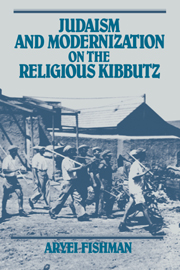Book contents
- Frontmatter
- Contents
- Preface
- Introduction
- PART ONE PROLOGUE
- PART TWO THE PARENT ORTHODOX MODERNIZING MOVEMENTS
- PART THREE THE RELIGIOUS KIBBUTZ MOVEMENT
- 4 The foundations of the Religious Kibbutz Movement
- 5 Charisma and rationalization
- 6 The halakhic–socialist collective
- 7 The confrontation between halakhah and external reality
- 8 Between heteronomous and autonomous authority
- Afterword
- Appendix A The Religious Kibbutz Federation settlements
- Appendix B About the religious kibbutz members quoted in this book
- Appendix C Ideological periodicals referred to in book
- Notes
- Index
4 - The foundations of the Religious Kibbutz Movement
Published online by Cambridge University Press: 29 October 2009
- Frontmatter
- Contents
- Preface
- Introduction
- PART ONE PROLOGUE
- PART TWO THE PARENT ORTHODOX MODERNIZING MOVEMENTS
- PART THREE THE RELIGIOUS KIBBUTZ MOVEMENT
- 4 The foundations of the Religious Kibbutz Movement
- 5 Charisma and rationalization
- 6 The halakhic–socialist collective
- 7 The confrontation between halakhah and external reality
- 8 Between heteronomous and autonomous authority
- Afterword
- Appendix A The Religious Kibbutz Federation settlements
- Appendix B About the religious kibbutz members quoted in this book
- Appendix C Ideological periodicals referred to in book
- Notes
- Index
Summary
In a summary of the settlement achievement of ha-Po'el ha-Mizrahi groups published in 1931, two communal groups of religious immigrants are mentioned, “Rodges” and “Shahal.” Each of these groups – the former from Germany and the latter from Eastern Europe – chose the kibbutz life-style independently, and they symbolized the two major geographical–cultural streams that were to converge in the founding of the Religious Kibbutz Federation. (A third, subsequent, component of the RKF in the pioneering period was the Bnei Akivah movement in Eretz Israel, which was to build kibbutz life within the mold cast by the major streams.)
In declaring for a kibbutz pattern of life, the members of Rodges and Shahal could draw upon the twenty-year experience of the secular kibbutz movement, which by 1931 had consolidated in three ideological federations. Thirty kibbutzim had already settled on the land. Many of them had originated as pioneering “nuclei” in the Diaspora, usually consisting of graduates of Zionist youth movements who had prepared themselves on training-farms sponsored by he-Halutz (the Pioneer) movement. Upon immigrating to Eretz Israel, the members of a pioneering nucleus would set up temporary quarters in a work-camp, in anticipation of settling on Jewish national land. Jewish-owned land was scarce until 1948, and a pioneering nucleus would usually have to wait from five to ten years for its turn to settle. In the meanwhile the group would endeavor to “flesh out” its kibbutz structure.
- Type
- Chapter
- Information
- Judaism and Modernization on the Religious Kibbutz , pp. 69 - 80Publisher: Cambridge University PressPrint publication year: 1992



